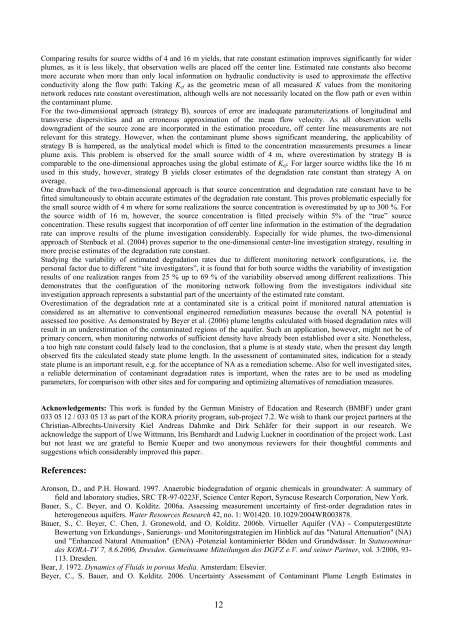Applied numerical modeling of saturated / unsaturated flow and ...
Applied numerical modeling of saturated / unsaturated flow and ...
Applied numerical modeling of saturated / unsaturated flow and ...
Create successful ePaper yourself
Turn your PDF publications into a flip-book with our unique Google optimized e-Paper software.
Comparing results for source widths <strong>of</strong> 4 <strong>and</strong> 16 m yields, that rate constant estimation improves significantly for wider<br />
plumes, as it is less likely, that observation wells are placed <strong>of</strong>f the center line. Estimated rate constants also become<br />
more accurate when more than only local information on hydraulic conductivity is used to approximate the effective<br />
conductivity along the <strong>flow</strong> path: Taking Kef as the geometric mean <strong>of</strong> all measured K values from the monitoring<br />
network reduces rate constant overestimation, although wells are not necessarily located on the <strong>flow</strong> path or even within<br />
the contaminant plume.<br />
For the two-dimensional approach (strategy B), sources <strong>of</strong> error are inadequate parameterizations <strong>of</strong> longitudinal <strong>and</strong><br />
transverse dispersivities <strong>and</strong> an erroneous approximation <strong>of</strong> the mean <strong>flow</strong> velocity. As all observation wells<br />
downgradient <strong>of</strong> the source zone are incorporated in the estimation procedure, <strong>of</strong>f center line measurements are not<br />
relevant for this strategy. However, when the contaminant plume shows significant me<strong>and</strong>ering, the applicability <strong>of</strong><br />
strategy B is hampered, as the analytical model which is fitted to the concentration measurements presumes a linear<br />
plume axis. This problem is observed for the small source width <strong>of</strong> 4 m, where overestimation by strategy B is<br />
comparable to the one-dimensional approaches using the global estimate <strong>of</strong> Kef. For larger source widths like the 16 m<br />
used in this study, however, strategy B yields closer estimates <strong>of</strong> the degradation rate constant than strategy A on<br />
average.<br />
One drawback <strong>of</strong> the two-dimensional approach is that source concentration <strong>and</strong> degradation rate constant have to be<br />
fitted simultaneously to obtain accurate estimates <strong>of</strong> the degradation rate constant. This proves problematic especially for<br />
the small source width <strong>of</strong> 4 m where for some realizations the source concentration is overestimated by up to 300 %. For<br />
the source width <strong>of</strong> 16 m, however, the source concentration is fitted precisely within 5% <strong>of</strong> the “true” source<br />
concentration. These results suggest that incorporation <strong>of</strong> <strong>of</strong>f center line information in the estimation <strong>of</strong> the degradation<br />
rate can improve results <strong>of</strong> the plume investigation considerably. Especially for wide plumes, the two-dimensional<br />
approach <strong>of</strong> Stenback et al. (2004) proves superior to the one-dimensional center-line investigation strategy, resulting in<br />
more precise estimates <strong>of</strong> the degradation rate constant.<br />
Studying the variability <strong>of</strong> estimated degradation rates due to different monitoring network configurations, i.e. the<br />
personal factor due to different “site investigators”, it is found that for both source widths the variability <strong>of</strong> investigation<br />
results <strong>of</strong> one realization ranges from 25 % up to 69 % <strong>of</strong> the variability observed among different realizations. This<br />
demonstrates that the configuration <strong>of</strong> the monitoring network following from the investigators individual site<br />
investigation approach represents a substantial part <strong>of</strong> the uncertainty <strong>of</strong> the estimated rate constant.<br />
Overestimation <strong>of</strong> the degradation rate at a contaminated site is a critical point if monitored natural attenuation is<br />
considered as an alternative to conventional engineered remediation measures because the overall NA potential is<br />
assessed too positive. As demonstrated by Beyer et al. (2006) plume lengths calculated with biased degradation rates will<br />
result in an underestimation <strong>of</strong> the contaminated regions <strong>of</strong> the aquifer. Such an application, however, might not be <strong>of</strong><br />
primary concern, when monitoring networks <strong>of</strong> sufficient density have already been established over a site. Nonetheless,<br />
a too high rate constant could falsely lead to the conclusion, that a plume is at steady state, when the present day length<br />
observed fits the calculated steady state plume length. In the assessment <strong>of</strong> contaminated sites, indication for a steady<br />
state plume is an important result, e.g. for the acceptance <strong>of</strong> NA as a remediation scheme. Also for well investigated sites,<br />
a reliable determination <strong>of</strong> contaminant degradation rates is important, when the rates are to be used as <strong>modeling</strong><br />
parameters, for comparison with other sites <strong>and</strong> for comparing <strong>and</strong> optimizing alternatives <strong>of</strong> remediation measures.<br />
Acknowledgements: This work is funded by the German Ministry <strong>of</strong> Education <strong>and</strong> Research (BMBF) under grant<br />
033 05 12 / 033 05 13 as part <strong>of</strong> the KORA priority program, sub-project 7.2. We wish to thank our project partners at the<br />
Christian-Albrechts-University Kiel Andreas Dahmke <strong>and</strong> Dirk Schäfer for their support in our research. We<br />
acknowledge the support <strong>of</strong> Uwe Wittmann, Iris Bernhardt <strong>and</strong> Ludwig Luckner in coordination <strong>of</strong> the project work. Last<br />
but not least we are grateful to Bernie Kueper <strong>and</strong> two anonymous reviewers for their thoughtful comments <strong>and</strong><br />
suggestions which considerably improved this paper.<br />
References:<br />
Aronson, D., <strong>and</strong> P.H. Howard. 1997. Anaerobic biodegradation <strong>of</strong> organic chemicals in groundwater: A summary <strong>of</strong><br />
field <strong>and</strong> laboratory studies, SRC TR-97-0223F, Science Center Report, Syracuse Research Corporation, New York.<br />
Bauer, S., C. Beyer, <strong>and</strong> O. Kolditz. 2006a. Assessing measurement uncertainty <strong>of</strong> first-order degradation rates in<br />
heterogeneous aquifers. Water Resources Research 42, no. 1: W01420. 10.1029/2004WR003878.<br />
Bauer, S., C. Beyer, C. Chen, J. Gronewold, <strong>and</strong> O. Kolditz. 2006b. Virtueller Aquifer (VA) - Computergestützte<br />
Bewertung von Erkundungs-, Sanierungs- und Monitoringstrategien im Hinblick auf das "Natural Attenuation" (NA)<br />
und "Enhanced Natural Attenuation" (ENA) -Potenzial kontaminierter Böden und Grundwässer. In Statusseminar<br />
des KORA-TV 7, 8.6.2006, Dresden. Gemeinsame Mitteilungen des DGFZ e.V. und seiner Partner, vol. 3/2006, 93-<br />
113. Dresden.<br />
Bear, J. 1972. Dynamics <strong>of</strong> Fluids in porous Media. Amsterdam: Elsevier.<br />
Beyer, C., S. Bauer, <strong>and</strong> O. Kolditz. 2006. Uncertainty Assessment <strong>of</strong> Contaminant Plume Length Estimates in<br />
12

















